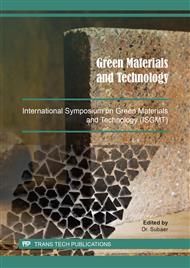[1]
International Agency for Research of Cancer: IARC Monographs, Vol. 73.
Google Scholar
[2]
WHO Guidelines for Drinking-water Quality, 4th еd., (2011).
Google Scholar
[3]
European Commission Council Directive 98/83/EC Оn the quality of water intended for human consumption: Off. J. Eur. Commun. L221 (2014) 1-101.
Google Scholar
[4]
D. Živojinović and L. Rajaković: Desalination 275 (2011) 17–25.
Google Scholar
[5]
M. Cengiz and A. Bilgin: J. Pharm. Biomed. Analysis 120 (2016) 190–197.
Google Scholar
[6]
I. Bajenaru, I. Minca, C. Guran, A. Josceanu and F. Bacalum: Rev. Chim. (Bucharest) 64 (2013) 1229-13.
Google Scholar
[7]
C. Lopez-Moreno, I. Viera and A. Urbano: Desalination 26 (2010) 111–116.
Google Scholar
[8]
A. Krata, V. Kontozova-Deutsch, L. Bencs, F. Deutsch and R. Van Grieken: Talanta 79 (2009) 16–21.
DOI: 10.1016/j.talanta.2009.02.044
Google Scholar
[9]
P. Miskaki, E. Lytras, L. Kousouris and P. Tzoumerkas: Desalination 213 (2007) 182–188.
DOI: 10.1016/j.desal.2006.05.063
Google Scholar
[10]
R.B. Costa, P.R. Camiloti, C.A. Sabatini, C.E.D. dos Santos, P.C.F. Lima Gomes and M.A.T. Adorno: Water Air Soil Pollut 229 (2018) 212.
DOI: 10.1007/s11270-018-3863-5
Google Scholar
[11]
E. Gilchrist, D. Healy, V. Morris and J. Glennon: Anal. Chim. Acta 942 (2016) 12-22.
Google Scholar
[12]
USEPA Method 302.0: Determination of bromate in drinking water using two-dimensional ion chromatography with suppressed conductivity detection, (2009).
Google Scholar
[13]
USEPA Method 300.1 Determination of inorganic anions in drinking water by ion chromatography, (1999).
Google Scholar
[14]
ISO 10304-1:2007 Water quality — Determination of dissolved anions by liquid chromatography of ions.
Google Scholar
[15]
M. El Haddad, R. Mamouni, M. Ridaoui and S. Lazar: J. Saudi Chem. Soc. 19 (2015) 108-111.
Google Scholar
[16]
M. K. Pappoe, M. H. Naeeni and C. A. Lucy: J. Chrom. A 1444 (2016) 57-63.
Google Scholar
[17]
H.B. Teh and S.F. Yau Li: J. Chrom. A 1383 (2015) 112-120.
Google Scholar
[18]
P. Zakaria, C. Bloomfield, R.A. Shellie, P.R. Haddad and G.W. Dicinoski: J. Chrom. A 1218 (2011) 9080-9085.
Google Scholar
[19]
Metrohm, Suppression in ion chromatography, metrohm.com.
Google Scholar
[20]
European Commission 2002 Decision 2002/657/EC implementing Council Directive 96/23/EC concerning the performance of analytical methods and the interpretation of results, Off. J. Eur. Commun. L221 8-36.
Google Scholar
[21]
M. Thompson, S. Ellison and R. Wood: Pure Appl. Chem. 74 (2002) 835–855.
Google Scholar
[22]
V. Ivanova, A. Surleva and B. Koleva: IOP Conf. Ser.: Mater. Sci. Eng. 374 (2018) 012053.
DOI: 10.1088/1757-899x/374/1/012053
Google Scholar
[23]
Eurachem Guide: The Fitness for Purpose of Analytical Methods - A Laboratory Guide to Method Validation and Related Topics, Magnusson B and Örnemark U (eds.) 2014 2nd ed.
Google Scholar
[24]
A. Kruve, R. Rebane, K. Kipper, M. Oldekop, H. Evard, K. Herodes, P. Ravio and I. Leito: Anal. Chim. Acta 870 (2015) 29-44.
DOI: 10.1016/j.aca.2015.02.017
Google Scholar
[25]
A. Kruve, R. Rebane, K. Kipper, M. Oldekop, H. Evard, K. Herodes, P. Ravio and I. Leito: Anal. Chim. Acta 870 (2015) 8-28.
DOI: 10.1016/j.aca.2015.02.016
Google Scholar


